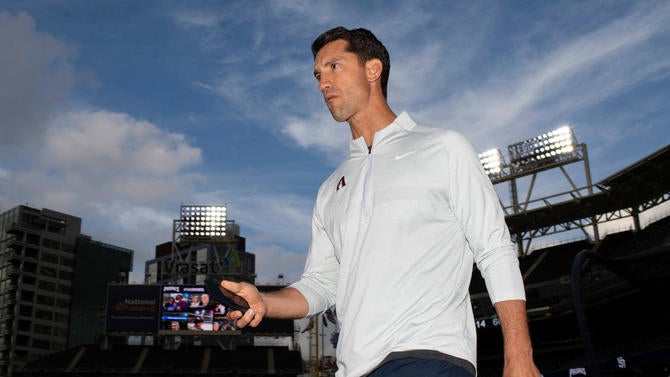What was expected to be a rebuilding year for the Diamondbacks was instead a surprisingly successful 2019 season. The club traded icon Paul Goldschmidt last offseason, and also lost stalwarts Patrick Corbin and A.J. Pollock to free agency. Rather than fade into rebuild obscurity, Arizona went 85-77 and finished with the National League's seventh best run differential (plus-70).
The D-Backs stayed afloat because Ketel Marte developed into an MVP candidate, Carson Kelly immediately stepped in as an above-average catcher, and slugging first baseman Christian Walker had a breakout year. Also, GM Mike Hazen managed to unload Zack Greinke's contract, and shrewdly picked up righty Zac Gallen in a trade with the Marlins. It was a productive deadline.
The Greinke trade freed up approximately $50 million in payroll from 2020-21, plus the club can look forward to the Yasmany Tomas contract coming off their books next offseason. He'll make $17 million in 2020, the final year of his six-year, $68.5 million contract. For the first time in a long time, the D-Backs have significant payroll flexibility this offseason. Look at their 2020 commitments:
- Guaranteed contracts (4 players): $20.17 million (via Cot's Baseball Contracts)
- Arbitration-eligibles (10 players): $50.15 million (via MLB Trade Rumors projections)
- Dead money: $27.33 million (owed to Tomas and Greinke in 2020)
That adds up to $97.65 million for 14 roster players, assuming Tomas spends 2020 in Triple-A again. Assume 12 pre-arbitration players to fill out the roster and the D-Backs are looking at roughly $105 million for their 26-man active roster next year. Injuries happen, of course, so it'll really be more like $110 million with call-ups and whatnot.
The D-Backs opened 2019 with a $123 million payroll. They opened 2018 at $132 million. Assuming they spend to a similar level in 2020 -- not a safe assumption in MLB's current spending climate, but humor me -- Arizona has about $20 million to play with this winter. They could non-tender Jake Lamb (projected $5 million) and Steven Souza (projected $4.125 million) to clear more payroll.

"I think we're moving towards a little bit more flexibility to open up opportunities in the free agent market and trade market," Hazen recently told Nick Piecoro of the Arizona Republic. "I don't think we're all the way there yet, but we are moving in that general direction."
Since taking over as general manager in 2016, Hazen has employed a very methodical and disciplined approach to roster-building, which has put the D-Backs in position to spend money to bolster an already strong roster this winter. They're unlikely to hand out another Greinke contract, but there are opportunities to spend smartly and help the team contend in 2020 and beyond.
Because there is nothing we love to do more as outsiders than spend an MLB team's money, here are six moves the D-Backs can make to improve their roster and contend next season, without blowing up their payroll long-term.
1. Trade for Marte to play center field
Marte (Ketel, not Starling) is an absolute star. The just turned 26-year-old authored a .329/.389/.592 batting line with 32 home runs with one of the lowest strikeout rates in baseball (13.7 percent) in 2019. He's a power/contact force a la Mookie Betts and Jose Ramirez. Marte did that while playing 89 games in center field and 45 at second base (and five at shortstop). Great, versatile player.
The D-Backs smartly signed Marte to a five-year, $24 million extension last March that will pay him only $34 million from 2020-24, assuming the two club options are picked up. That team-friendly contract is one reason the team is in such good position to spend this winter. They don't have to worry about Marte getting big arbitration raises or hitting free agency anytime soon.
Marte's flexibility allows Hazen to look for a second baseman or a center fielder this winter. If they add a second baseman, they can put Marte in center. If they find a center fielder, Marte can play second. Nice and easy. In that case, I propose trading for Pirates center fielder Starling Marte, one of Dayn Perry's top offseason trade candidates, and moving the other Marte to second full-time.
Marte (Starling, not Ketel) is owed $11.5 million in 2020 with an affordable $12.5 million club option for 2021. Baseball America ranked Arizona's farm system the 16th best in baseball in August and called it "the biggest post-deadline riser" thanks to the Gallen pickup and the four-prospect haul in the Greinke trade. The D-Backs could try to build a Marte package around:
- MLB ready righty Jon Duplantier.
- Double-A catcher (outfielder? second baseman?) Daulton Varsho.
- Near MLB ready righty Taylor Widener or Tommy John surgery rehabber Corbin Martin.
The D-Backs don't have to give up all those guys to get Marte, but perhaps a Varsho and Widener package with a third piece can get it done. Or Duplantier and Martin if Pittsburgh wants higher end pitching. Arizona has the prospect depth to put together a three or even four-player package good enough to win a Marte bidding war.
Of course, the Pirates do not have a general manager at the moment, and it seems unlikely they would move Marte, their most valuable trade asset, before settling their front office situation. Once they do, the D-Backs should be on the horn trying to swing a deal for Marte. Two Martes are better than one. Starling in center and Ketel at second is a heck of a combination.
2. Sign Dickerson for left field
Two years ago the D-Backs acquired Souza as part of a three-team, eight-player trade with the Rays and Yankees with the idea that he would be their everyday right fielder. Instead, injuries have limited Souza to 72 games the last two years, including zero in 2019. He's dealt with serious pectoral and knee injuries.
Given the injuries, I don't see how the D-Backs could pay Souza his projected $4.125 million salary in 2020. There's too much risk and it's been too long a layoff to count on him producing in a meaningful way. Maybe Arizona could non-tender Souza and re-sign him at a lower rate, but I'm not sure it's worth locking him into a roster spot. There are upgrades available.
Among those potential upgrades: Corey Dickerson. The free agent slugger hit .304/.341/.565 with 12 homers in 78 games around back and foot injuries with the Pirates and Phillies in 2019. The man has done nothing but hit since becoming a full-time player in 2014. His year-by-year park-adjusted offensive output:
- 2014: 141 OPS+
- 2015: 118 OPS+
- 2016: 106 OPS+
- 2017: 118 OPS+
- 2018: 118 OPS+
- 2019: 131 OPS+
Only once in his six full seasons has Dickerson not been at least 18 percent better than league average offensively and never once has he been worse than six percent better than league average. His 121 OPS+ since 2014 is a top 30 mark in baseball, right behind Manny Machado (124 OPS+) and just ahead of Charlie Blackmon (120 OPS+).
Dickerson can really hit, he's turned himself in a competent defensive left fielder, and he won't cost an arm and a leg to sign. The freaky accurate FanGraphs crowdsourcing results project a two-year worth $8 million annually. Dickerson at $8 million or do you spend a little more than half that hoping Souza stays healthy and can be productive following a lost season? Easy call for me.
Signing Dickerson would push David Peralta back to right field, the position he's played throughout his MLB career, and all but guarantee speedy Tim Locastro gets used a defensive replacement in the late innings. Who he replaces (Dickerson or Peralta) would depend on where the D-Backs are in the lineup and who's still due to get an at-bat in a close game.
Also, it's worth noting two years for Dickerson and one year plus an option for Marte give the D-Backs some outfield protection going forward. Peralta can be a free agent after next season and top outfield prospects like Kristian Robinson and Alek Thomas are at least a year away, maybe two. Dickerson and Marte allow Arizona to be patient with their top youngsters.
3. Sign Holt for the bench
Hazen has acquired several former Red Sox players since joining the D-Backs. He spent 10 years in Boston's front office, including the final five as assistant GM or GM. Clay Buchholz, Rey Fuentes, Deven Marrero, Robby Scott, and Blake Swihart are among the former Red Sox players or prospects Hazen has acquired since joining Arizona. Hazen also hired longtime Red Sox coach Torey Lovullo to be the D-Backs' manager three years ago.
Brock Holt is this offseason's Marwin Gonzalez, who was last offseason's Ben Zobrist. That free agent who fits any team because he can play pretty much anywhere. Holt and Hazen have a history dating back to their time with the Red Sox, and the D-Backs can offer playing time all around the infield and in the outfield corners, plus regular pinch-hitting appearances.
In the year 2019, the name of the game is quality depth. The more good players on your roster, the better, and Holt has already shown he can be productive and versatile in a part-time role. It's not an easy job. Considering injuries, it really would not take much for Holt to get 400-something plate appearances with the D-Backs in 2020, a total he hasn't reached since 2015.
My guess is Holt will look for a starting job somewhere and it'll only take one team to offer that job -- can't you see the Athletics offering him their second base gig given how much Jurickson Profar struggled this year? -- but I think there's enough of a chance to win with Arizona and enough playing time available to lure him to the D-Backs. The connection to Hazen only helps. It's an obvious fit, as our R.J. Anderson recently noted.
The FanGraphs crowdsourcing results project a two-year deal at $4 million annually for Holt. In this scenario, I'd non-tender Lamb rather than pay his projected $5 million salary, and move forward with Holt as the primary lefty pinch-hitter and backup at first and third bases. Here's the lineup following our hypothetical Dickerson, Holt, and Marte moves:
- 2B Ketel Marte
- CF Starling Marte
- 3B Eduardo Escobar
- RF David Peralta
- 1B Christian Walker
- LF Corey Dickerson
- C Carson Kelly
- SS Nick Ahmed
- Pitcher's spot
Bench: C Caleb Joseph, IF Domingo Leyba, OF Tim Locastro, UTIL Brock Holt, UTIL Ildemaro Vargas
Depth: 1B Kevin Cron, UTIL Josh Rojas
Remember, MLB shifts to a 26-man roster next season with a 13-pitcher/13-position player mandate. That means a five-man bench for National League squads.
4. Sign Pineda as rotation depth
Even after trading Greinke and possibly dealing Duplantier in our hypothetical Marte trade, the D-Backs do have solid depth in the starting rotation. That said, several of their starters come with questions or injury concerns. The current rotation depth chart:
- LHP Robbie Ray (always in trade rumors)
- RHP Mike Leake
- RHP Luke Weaver (missed close to four months this year with an elbow injury)
- RHP Zac Gallen
- RHP Merrill Kelly
- RHP Taijuan Walker (returning from Tommy John surgery)
- LHP Alex Young
- RHP Taylor Clarke
Weaver successfully rehabbed an ulnar collateral ligament injury after initial concern he would need Tommy John surgery. The fact he completed the rehab is good. Most pitchers blow out and have surgery before making it back to MLB when they attempt to rehab a ligament tear. Still, his injury has to create some concern about his long-term durability.
Walker completed his Tommy John surgery rehab late this year -- he made a one-inning relief appearance in September -- and, even though he will become a free agent after next season, it seems unlikely the D-Backs will push him hard in his first year back from elbow reconstruction. They figure to monitor his workload to some degree. It's the smart and player-friendly thing to do.
Long story short, the D-Backs could use additional rotation depth much like every team can use rotation depth. Free agent righty Michael Pineda had a solid first full season back from Tommy John surgery with the Twins, and he was especially good following the All-Star break (3.04 ERA). Alas, a performance-enhancing drug suspension ended his season in September.
Pineda has to serve the final 39 games of his 60-game suspension next season, so he is eligible to return May 9 at the Brewers. That gives the D-Backs a little more than a month to evaluate Weaver's health, monitor Walker's workload, and gauge the trade market for Ray, a free agent to be. Getting a guy like Pineda back in May would be a nice little shot in the arm.
The FanGraphs crowdsourcing results project a two-year deal at $11 million annually for Pineda. He does not get paid during his suspension, however, so his pro-rated salary it would be approximately $8.4 million in 2019. Essentially stashing a league average-ish starter with a penchant for strikeouts until early May would be a nifty little depth move.
5. Sign Pomeranz for the bullpen
The D-Backs have most of their bullpen in place. Archie Bradley has the ninth inning locked down and righties Kevin Ginkel and Yoan Lopez are solid setup options. Andrew Chafin has been one of MLB's best left-on-left matchup relievers the last few years, but he has had trouble with righties at times, and the new three-batter minimum rule could limit his usefulness going forward.
Like every team though, the D-Backs could use more help in the bullpen, including another late-inning option. Someone to help Ginkel and Lopez (and Chafin) get the ball to Bradley. To me, the most intriguing free agent reliever is Drew Pomeranz, who started this past season in the Giants rotation and finished it in the Brewers bullpen. The change in performance was considerable:
| IP | ERA | WHIP | K rate | BB rate | GB rate | FB velo | |
|---|---|---|---|---|---|---|---|
As starter | 75 1/3 | 5.97 | 1.66 | 24.9% | 10.3% | 36.4% | 92.0 mph |
As reliever | 28 2/3 | 1.88 | 0.84 | 47.2% | 7.6% | 51.1% | 94.3 mph |
Yes, a 28 2/3-inning sample is nothing, but it's all we have for Pomeranz as a reliever. His fastball velocity increased noticeably -- Pomeranz is hardly the first pitcher to experience a velocity spike after moving into the bullpen -- and the strikeouts and ground balls followed. He was dominant in those 28 2/3 relief innings.
Do I expect Pomeranz to be a sub-2.00 ERA reliever with a near 50 percent strikeout rate going forward? No. No I do not. Those numbers are pretty much unsustainable. I do think the tools are there for him to be an impact reliever, however. Pomeranz is a former high draft pick (fifth overall in 2010) who had several good years as a starter, and now looks ready to carve out a second phase of his career in the bullpen.
The FanGraphs crowdsourcing results project a two-year deal at $6 million annually for Pomeranz. That's a little more than I was expecting, but I think it's worth the risk. The D-Backs have money to spend and it's a short-term contract with considerable upside. If Pomeranz flames out, oh well. It won't stop Arizona from doing anything else. But, if the Pomeranz we saw out of the bullpen last year is the real Pomeranz, oh boy. What a bargain.
6. Sign Martin for the bullpen too
Got money to spend and you need bullpen help? Why not sign another reliever. Chris Martin's season came to an unfortunate end -- he injured his oblique in NLCS Game 1 with the Braves -- but he had a marvelous year overall, pitching to a 3.40 ERA with 65 strikeouts and only five walks in 55 2/3 innings with the Rangers and Braves.
Martin bounced around a bit early in his MLB career, then seemed to find himself as a pitcher during a two-year stint in Japan with the Nippon Ham Fighters. Texas gave him a two-year deal two years ago, he proved the success he had in Japan was no fluke, and now he's in position to cash in nicely as a free agent at age 33. The stint in Japan saved his career.
The D-Backs have a history of signing players from Asia under Hazen. Two years ago they gave Japanese righty Yoshihisa Hirano a two-year contract worth $6 million, and last year they signed Kelly away from the SK Wyverns in Korea with a two-year, $5.5 million deal. Martin has spent the last two years in MLB, but clearly, the D-Backs scout Asia, so surely they have a book on him from his time in Japan.
The FanGraphs crowdsourcing results project a two-year deal at $4.5 million annually for Martin. Adding him and Pomeranz to the bullpen would give the D-Backs this relief unit heading into next season:
- Closer: RHP Archie Bradley
- Setup: RHP Yoan Lopez, LHP Drew Pomeranz
- Middle: LHP Andrew Chafin, RHP Kevin Ginkel, RHP Chris Martin, RHP Jimmie Sherfy
- Long: RHP Matt Andriese
- Injured: RHP Silvino Bracho (rehabbing from Tommy John surgery)
The math works out well. Way back in the intro we had $97.65 million for 14 roster players. Non-tendering Lamb and Souza gets us down to $88.525 million for 12 roster players. Add Marte ($11.5 million), Pineda ($8.4 million), Dickerson ($8 million), Pomeranz ($6 million), Martin ($4.5 million), and Holt ($4 million) gets us to $130.925 million for 18 roster players.
Fill out the rest of the active 26-man roster -- remember, Pineda has to serve his suspension, so he needs to replaced for the first 39 games of 2020 -- with pre-arbitration-eligible players and we're at $135 million or so on Opening Day, right in line with Arizona's Opening Day payrolls the last two years.
The lineup is deeper with Marte and Dickerson, the rotation has extra depth with Pineda, and the bullpen is stronger with Martin and Pomeranz. No onerous long-term big money contracts and no blocked prospects down the line. The D-Backs were close to contending in 2019 and their core remains in place. They have money to spend this offseason and a few smart pickups can put the team over the top without tying them down financially long-term.




























